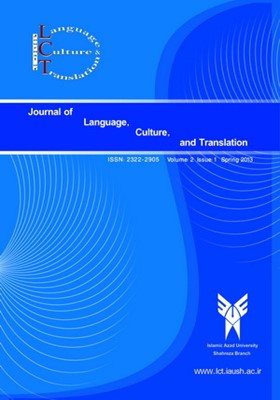Does Communicative Language Teaching Really Work? A Critical Appraisal
محورهای موضوعی : نشریه تخصصی زبان، فرهنگ، و ترجمه (دوفصلنامه)زهرا معصوم پناه 1 , محمد رضا طالبی نژاد 2
1 - دانشگاه فرهنگیان، خرم آباد، ایران
2 - گروه زبان انگلیسی، دانشگاه آزاد اسلامی، واحد شهرضا، ایران
کلید واژه: framework, Communicative language teaching, Critical appraisal,
چکیده مقاله :
When asked to identify the methodology they employ in their classrooms, most teachers claim to use “Communicative Language Teaching” (CLT). Even with the shift of attention from insistence on methods toward post method condition, CLT has not lost its dominance in ELT. However, most teachers neither stop such a claim nor think critically why they do so. Therefore, this paper is an attempt to go through a critical appraisal of Communicative Language Teaching. This is done first by going through a brief review on the basic claims, tenets, barriers and problems of implementing CLT especially in EFL contexts. Then, a framework is proposed touching upon the shortcomings of the available models and theories for criticizing language teaching methods. Finally, it looks at how the design is implemented in practice by focusing on CLT and examines the framework based on the claims and tenets of CLT, with particular reference to research findings and available literature. It is argued that CLT helps learners in building automaticity and self-confidence; empowering meaningful learning; developing intrinsic motivation; employing multiplicity of strategies; and fending for learners’ language ego. Culture, sociopolitical consciousness and interlanguage stages of development are important to CLT. It allows for the initiative of the learner and is most probable to be informed by a mediation rather than medium view. However, there are several problems with CLT. The most important one is in regard with the practicality, unilaterality, and non reflexivity of method. Moreover, it assumes teachers as helpless victims of ideological imposition and disregards their agency in the teaching / learning process.
هنگامی که از معلمان درمورد روش تدریس آنها در کلاس های درس میپرسیم، بیشترانها ادعا می کنند که ازروش " آموزش زبان ارتباطی " ( CLT) استفاده میکنند. حتی با وجود تغییر توجه از اصرار بر دوره" روشهای تدریس" به دوره "پس از روشهای تدریس"، CLT سیطره خود را در آموزش زبان از دست نداده است . با این حال، بسیاری از معلمان نه از چنین ادعایی دست برمیدارند و نه نقادانه فکر می کنند که چرا این کار را انجام میدهند. بنابراین، در این مقاله تلاش شده تا یک ارزیابی انتقادی از "روش تدریس زبان ارتباطی CLT" بعمل آید. برای این کار،ابتدا یک بررسی کوتاه در مورد ادعاهای اساسی، اصول ، موانع و مشکلات اجرای CLT به ویژه درمحیط انگلیسی بعنوان یک زبان خارجه انجام می شود. سپس، یک چارچوب، که در آن تلاش شده کاستی های مدل های موجود رفع شود، جهت نقد روش های تدریس زبان ارائه شده است. در نهایت، مدل ارائه شده، عملا با تمرکز بر CLT اجرا ، و ادعاها و اصول CLT با توجه به یافته ها و منابع و تحقیقات موجود آزمایش میشود. استدلال این است که CLT به زبان آموزان کمک می کند تاخودکار وبا اعتماد به نفس عمل کنند؛ یادگیری معنی داررا درآنها تقویت میکند, انگیزه درونی را توسعه میدهد,کمک میکند از تعداد زیادی استراتژی استفاده کنند, و از "خود"شان دفاع کنند، فرهنگ، آگاهی سیاسی و اجتماعی و مراحل توسعه زبان در CLT مهم است. به یادگیرندگان اجازه ابتکار می دهد و به احتمال زیاد زبان بعنوان یک واسطه است تا یک وسیله. با این حال، چندین مشکل در CLT وجود دارد. مهم ترین آنها در ارتباط با عملی بودن، یک جانبه بودن ، و عدم انعطاف پذیری روش است . علاوه بر این، معلمان قربانیان درمانده ایدئولوژیهایی فرض میشوند که برآنها تحمیل میشوند و نقش آنها در فرایند تدریس / یادگیری نادیده گرفته میشود.


